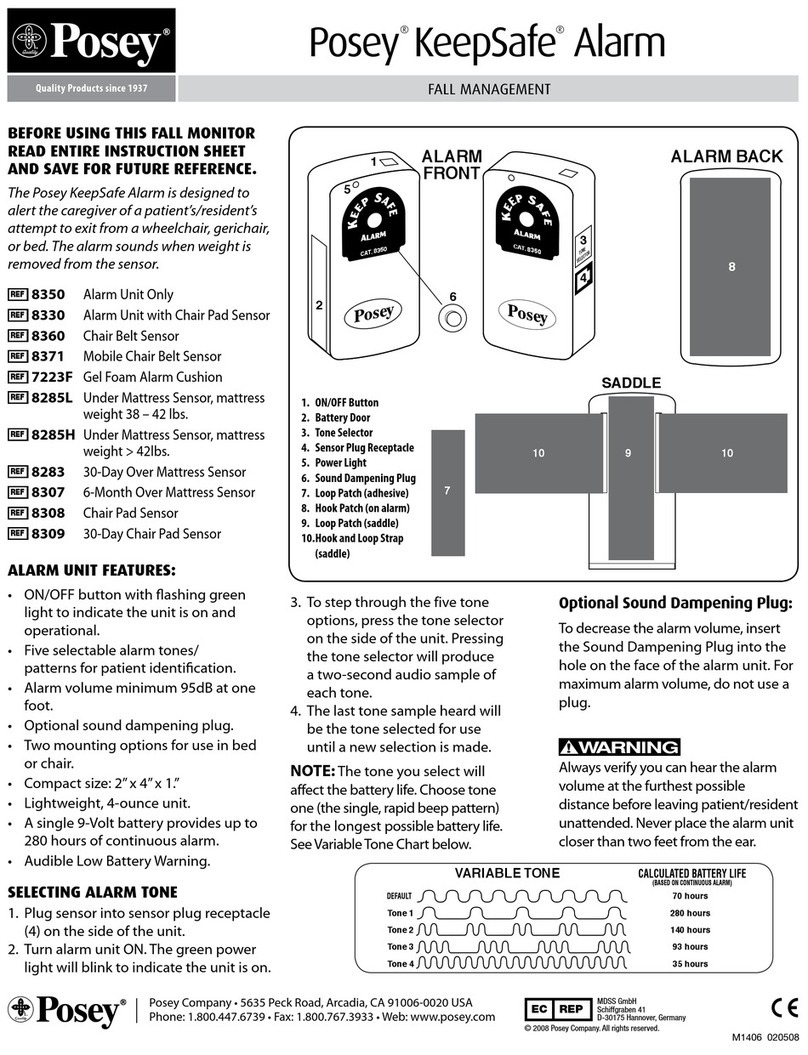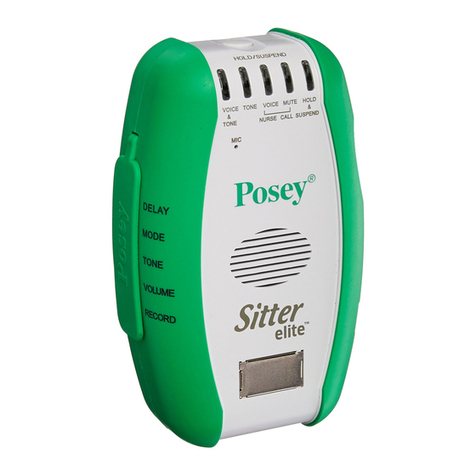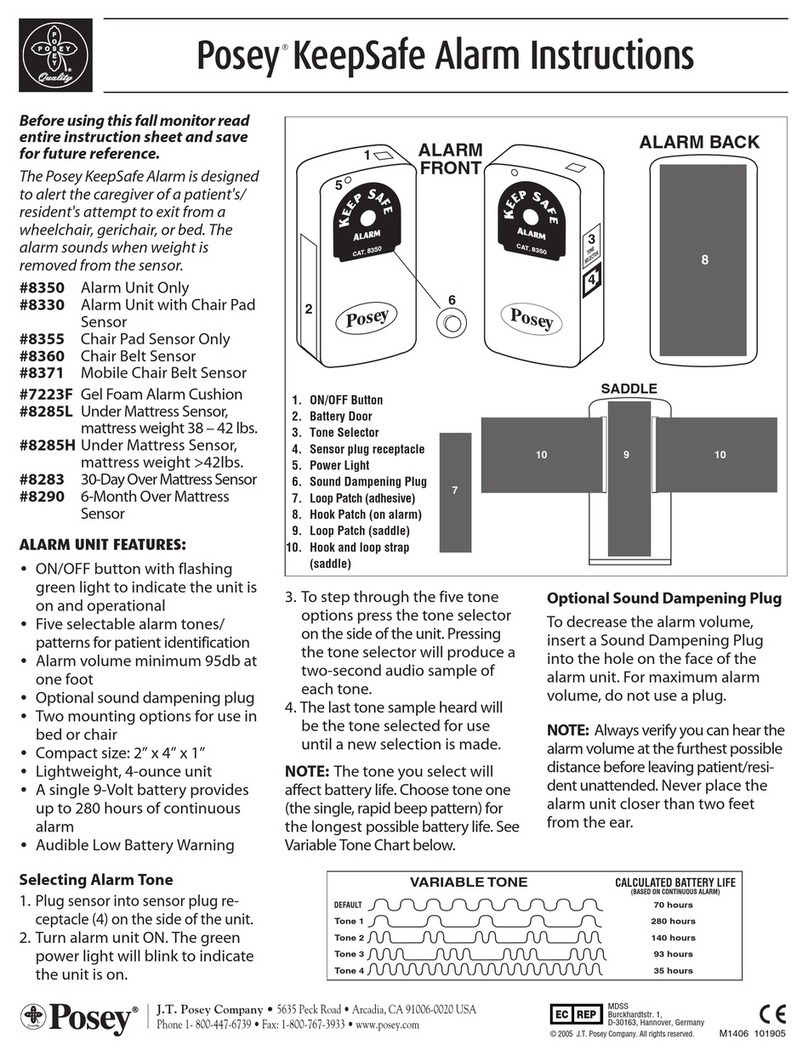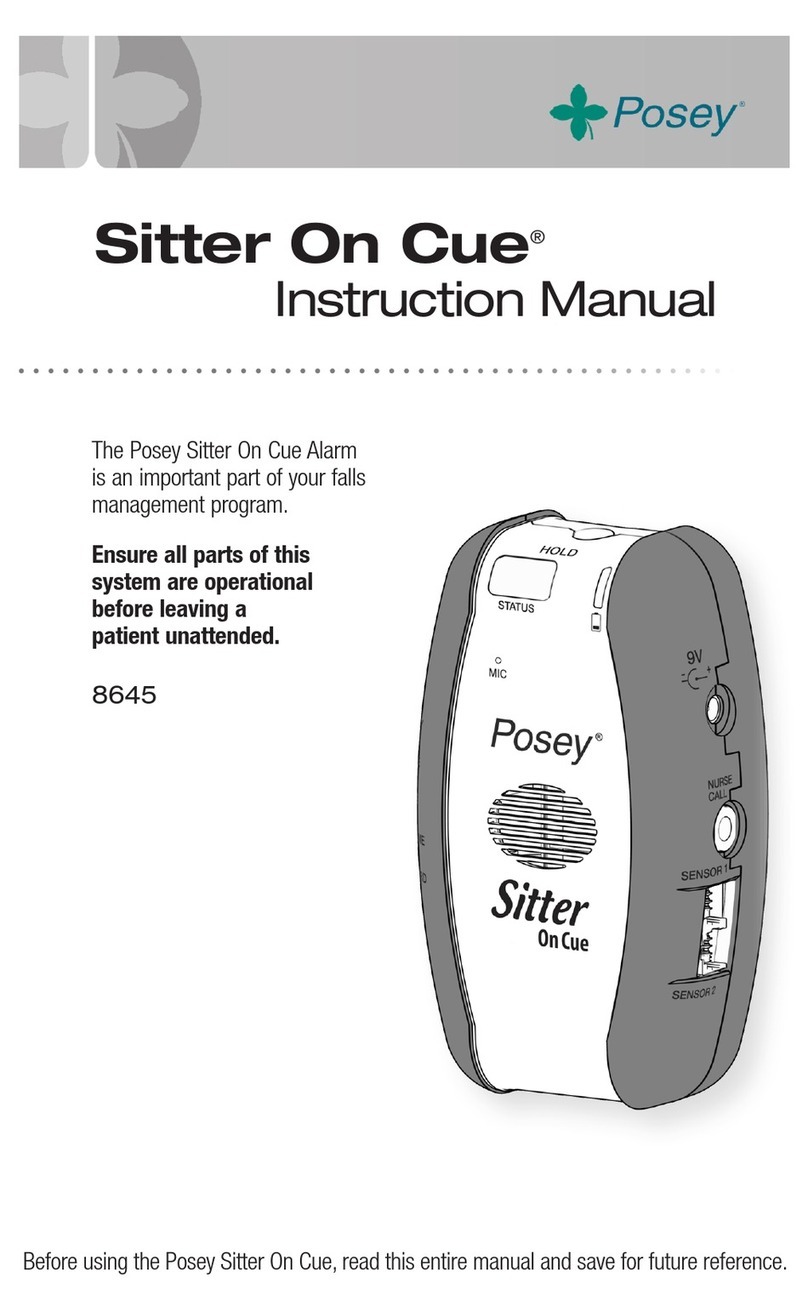
MOUNTING ALARM:
Saddle Mount–
1. Choose a secure location out of the
patient’s reach to attach the saddle, i.e.
leg of bed or bottom of wheelchair
frame at a juncture not likely to inter-
fere with the wheel of the chair (Fig. 1).
2. Wrap the saddle strap firmly and securely
around the wheelchair or bed frame.
3. Be sure the saddle is securely in place
and will not move.
4. Attach the alarm to the saddle (Fig. 2)
by mating the hook (10) and loop (11).
5. Press the alarm firmly in place (Fig. 3).
Fig. 6 - Chair Application
Fig. 5 - Bed Application
Fig. 4 Headboard Mount
4. Press the hook (rough) patch (10) on
the back of the alarm firmly to the
loop patch on mounting surface.
CONNECTING PATIENT/RESIDENT:
The Posey Personal Alarm may be used to
monitor a patient/resident in bed (Fig. 5),
in a wheelchair (Fig. 6) or in the
bathroom.
1. To connect patient, determine safety
zone range, adjust cord length with
slide adjuster (4). Cordadjusts from 31
inches to 60 inches in length.
MAINTAINING HOOK AND LOOP:
If hook and loop does not adhere, it is most
likely due to collection of dust and lint.
Clean hook by brushing with a stiff brush.
To avoid possible injury or death:
It is the caregiver’s responsibility to
select the appropriate cord length for
each patient. All of the following should
be considered:
•Cordshould belong enough to allow
moderate movement to enhance
sleep comfort, yet shortenough to
activate the alarm and notify caregiv-
er that the patient has left the prede-
termined safe range of mobility.
•Ifthe alarm is mounted on the wall the
extra distance from the headboard to
the wall must be considered.
•If the bed is elevated or lowered, cord
length should be changed accordingly.
A cordthatis too short to accommo-
date movement may result in a "false
alarm". A cord that is too long could
allow the patient to move beyond the
predetermined safe range of mobility.
•Ensure the cord is free to pull straight
out from the monitor and is not blocked
bypillowsor beddings, and is not entan-
gled in the siderails or headboard.
•Always verify alarm is properly
mounted and working properly
before leaving patient unattended.
•When used in conjunction with siderails,
besurecord length accommodates
the siderails and is not subject to
entanglement.
LIMITED LIFETIME WARRANTY:
The Posey Company warrants, to the
original purchaser, this alarm unit to be
free from defects in materials and
workmanship for the life of the unit.
Warranty void if unit is opened, dam-
aged, or submerged. See Catalog for
additional details.
Fig. 1 Wheelchair Mount
Fig. 2
Fig. 3
Adhesive Mount–
1. Choose site on headboard or other
mounting surface, i.e. nightstand or
toilet, out of patient’s reach (Fig. 4).
2. Clean site with alcohol wipe,let dry.
3. Attach self-adhesive loop (fuzzy)
patch (9) by peeling off backing and
pressing into place on the mounting
surface.
Note: Adhesive on loop patch will not
adhere well to vinyl or similar surface.
2. Attach the clip to the patient, near
the shoulder, on a piece of clothing
the patient is not likely to remove.
This should be out of the
patient’s/resident’s reach, if possible.
Note: Test alarm volume before each use.
REPLACING 9-VOLT BATTERY:
1. Make sure magnet is attached to metal
plate.
2. Slide door (1) on side of unit down to open.
3. Pull on ribbon to release the battery from
its chamber.
4. Disconnect battery from the battery clip.
5. Connect new 9-volt battery securely to
battery clip.
6. Place battery in chamber and slide door
back into place.
7. Press tone selector button to desired tone.
8. Check alarm function by disengaging
magnetic block from the metal plate on
the front of the alarm.
To avoid possible injury
or death: Always check the mounting
before each use, making sure the
alarm is securely positioned.
J.T. Posey Company•
5635 Peck Road • Arcadia, CA 91006-0020 USA • Tel: 800-447-6739 or 626-443-3143 • Fax: 800-767-3933 or 626-443-5014 • www.posey.com
























